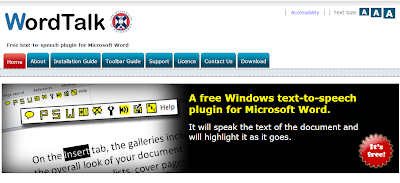Assitive technologies that are available to us as teachers by Katlyn Lusker, Tarcela Kohn, and Jake Dukes
According to wikipedia.org, "assistive technology is a term that includes assistive, adaptive, and rehabilitative devices for people with disabilities and also includes the process used in selecting, locating, and using them." "Assistive technologies promote greater independence by enabling people to perform tasks that they were formerly unable to accomplish, or had great difficulty accomplishing, by providing enhancements to, or changing methods of interacting with, the technology needed to accomplish such tasks." There is great diversity in today's classrooms. It's one of the most remarkable aspects of modern education. Students of all disabilities study in all classrooms from kindergarten up through college now, due to mainstreaming and inclusion policies. This benefits both disabled and non-disabled students. However, this can create challenges for teachers. Thankfully, teachers today can implement many new technologies to assist and aid students with disabilities, whether those students are in a traditional or online classroom (teachthought.com).
Word Talk By Katlyn Lusker
Word talk is also an assistive technology available to teachers. It is a free text-to-speech plugin developed and designed for use with all versions of Microsoft Word. Word talk is very beneficial for people with reading and writing difficulties. Having text reinforced by having it read out loud can be very useful. Children especially who have reading and writing difficulties, benefit when they have text read aloud to them. In schools this may be done by an assistant, however, assistants can be expensive, and their presence may be greatly needed somewhere else. Word talk has special features that include: speaking the text of a document and highlighting words as it goes, the voice and speed of the speech may be adjusted, the speech may be saved as an audio file, and a person is able to choose whether it speaks the entire document, a single paragraph, a sentence, or just a word (wordtalk.org).
Screen Readers By Tarcela Kohn
Some Assistive Technologies include: screen readers for the blind individuals, or screen magnifiers for low-vision can be used for the vision impaired. Screen readers are software programs that allow blind and visually impaired users to read text aloud that is displayed on the screen in word processor, web browser, e-mail programs or other applications. The user sends commands by pressing different keys on the keyboard which instructs the speech synthesizer to say and speak the text. The screen readers are available for personal computers that are running Linux, Windows 98, Windows ME, Windows NT, Windows 2000 and Windows XP operating systems. Screen reader’s benefit the blind and vision impaired, but it could also be used for an individual with vision. This software can be used when traveling and an individual struggling to read text while leaning close to the computer screen.
Hearing Assistive Technology Systems (HATS) By Tarcela Kohn
Hearing assistive technology systems (HATS) are devices that help individuals with hearing impairments function better in their day-to-day communication situations. There are several types of assistive listening devices that are available for improving sound transmission for hearing loss. Some of these devices are found in the classroom, theaters, airports, and place of worship and then one-on-one conversations in a small setting or group. The ALD systems for the larger facilities include hearing loops, frequency-modulated (FM) systems, and infrared systems. I will be explaining the hearing loop system; it is a system that uses an electromagnetic energy to transmit sound. There are four parts to a hearing loop system: a sound source, such as a public address system, microphone, or home TV or telephone, an amplifier, a thin loop of wire that encircles a room or branches out of the carpeting and a receiver worn in the ears or as a headset. The sound that has been amplified travels through the loop and creates an electromagnetic field that is picked up by the receiver that is being worn.
Model me Going Places By Jake Dukes
This is an application that can be used on any apple product such as an ipad, iphone, or itouch. This app is for kids that have autism. This app puts the kids in situations where they would have to choose what they do themselves. It puts the kids in social situations where kids with autism would have hard times dealing with. This app can make it where kids that suffer from social awkwardness make it easier for them to deal with being around people. In this app you decide what you say and do in the group of people or wherever you are at in the game. We feel like this is a good idea for kids and think that it would help them out going forward in life. It also tells you things that you should do at every particular place such as restaurants and playgrounds. This is a very useful app.



No comments:
Post a Comment